地铁车辆主要狩猎模式的模态耦合特性:车体悬挂模式和打猎模式
IF 2.1
4区 工程技术
Q3 ENGINEERING, CIVIL
Proceedings of the Institution of Mechanical Engineers Part F-Journal of Rail and Rapid Transit
Pub Date : 2024-07-23
DOI:10.1177/09544097241266915
引用次数: 0
摘要
由于与轨道车辆的车体悬挂模式存在耦合,一次猎跑会导致车体出现明显的低频摇摆,严重影响乘坐质量。为了解决这一问题,本文对地铁车辆悬挂模式与打猎模式之间的耦合效应进行了详细研究。首先建立了一个简化的横向动力学模型,并采用连续模态跟踪方法对悬挂模态和狩猎模态进行跟踪。结果表明,当一种狩猎模式的模态频率接近相应悬挂模式的模态频率时,两种模式的阻尼比出现异常变化,模态频率曲线出现偏移或轻微紊乱。在探讨狩猎模态和悬浮模态的耦合特性、揭示模态振型的变化趋势和相似性时,给出了模态振型的极坐标图,并计算了相关距离。等效锥度对模态耦合效果有很大影响,影响模态耦合区内的最小阻尼比和模态振型相似性。为确保地铁车辆有足够的稳定裕度,有必要避免过低的等效同轴度。最后,通过简化模型和全 DOF 模型证实了模态耦合区内振动响应恶化的现象。本文章由计算机程序翻译,如有差异,请以英文原文为准。
Modal coupling characteristics of primary hunting in metro vehicles: Carbody suspension modes and hunting modes
Due to coupling with carbody suspension modes in railway vehicles, primary hunting can lead to significant low frequency swaying of the carbody, severely deteriorating ride quality. In order to address this issue, this paper conducts a detailed investigation into the coupling effect between suspension modes and hunting modes of metro vehicles. Initially, a simplified lateral dynamics model is established, and a continuous modal tracking method is adopted for track suspension modes and hunting modes. The results indicate that when the modal frequency of one hunting mode approaches that of corresponding suspension mode, the damping ratio of the two modes exhibits abnormal variation, and the modal frequency curve veers or is slightly disturbed. In exploring the coupling characteristics of hunting modes and suspension modes, revealing the variation trends and similarity of modal shapes, polar diagrams of modal shapes are presented, and the correlation distance is calculated. Equivalent conicity exerts a substantial influence on the effect of modal coupling, influencing minimum damping ratio and modal shape similarity within the modal coupling zone. To ensure sufficient stability margin for metro vehicles, it is necessary to avoid excessively low equivalent conicity. Finally, the phenomenon of vibration response deterioration within the modal coupling zone is confirmed through both a simplified model and a full DOF model.
求助全文
通过发布文献求助,成功后即可免费获取论文全文。
去求助
来源期刊

CiteScore
4.80
自引率
10.00%
发文量
91
审稿时长
7 months
期刊介绍:
The Journal of Rail and Rapid Transit is devoted to engineering in its widest interpretation applicable to rail and rapid transit. The Journal aims to promote sharing of technical knowledge, ideas and experience between engineers and researchers working in the railway field.
 求助内容:
求助内容: 应助结果提醒方式:
应助结果提醒方式:


